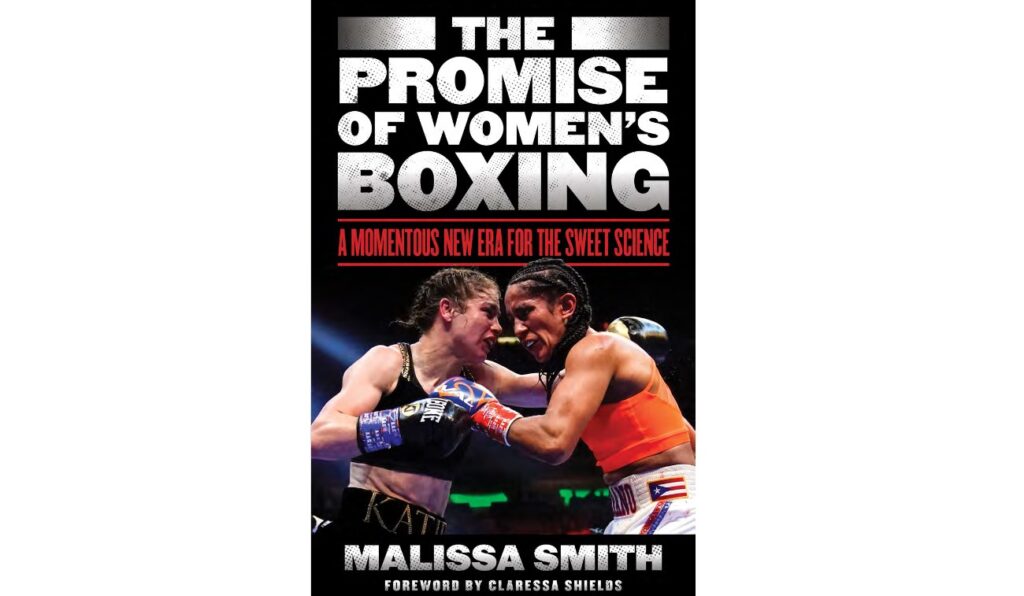Women's boxing has come a long way from being a novelty, a sideshow, or a special event in the shadow of men's boxing. Author Marissa Smith has attempted to document its history with academic rigor and literary flair in her classic The History of Women's Boxing, and her latest book is another example of her dedication to the endeavor.
Titled “a timely exploration of modern women's boxing from its first inclusion in the Olympics in 2012 to today,” Smith's recently published magnum opus, “The Future of Women's Boxing” (Rowman & Littlefield Publishers, 292 pages), tells the story of women's boxing's coming of age in the 21st century, with the emergence of many pioneers including Katie Taylor, Amanda Serrano and Claressa Shields.
After a highly informative preface covering the entire history of women's boxing to date, Smith delves into the beginnings of what is already considered the sport's golden age, shortly after the explosive rise of pioneers such as Christy Martin and Lucia Rijker in the 90s. Fighters such as Alicia Ashley and Heather Hardy emerged from women's boxing's first Olympic Games, paving the way for a new generation that changed the game forever, launching the professional careers of fighters such as Taylor, Shields, Mikaela Mayer and Natasha Jonas, among many others.

Claressa Shields wrote the foreword to Smith's latest book – Photo by Tom Casino/Showtime
The generational clash between the older generation of fighters who grew up on the front lines of combat, paying for their own training and controlling their careers by selling tickets to their own shows, and the newcomers who are fighting for equal pay with their male counterparts and whose groundbreaking achievements are propelling their careers into multi-million dollar territory, is one of the book's most fascinating features, giving you a sense of exponential growth in real time.
These fighters' personal stories are only a small part of the journey. Smith's meticulous research into the minutiae of their careers and how they helped make women's boxing one of the fastest-growing sports in recent memory is impressive. The 20-year story of the transition from low-paid preliminaries to multi-million dollar prize money, the growing interest of promoters and television networks, and the shift in boxing fan base from skepticism to admiration is detailed.
Just as her previous book, “The History of Women's Boxing,” described a long and difficult process, this book follows that first big bang, followed by the explosive growth that gave birth to the generation of the greatest female fighters of all time. Stories of women's struggles in other countries, such as pound-for-pound queen Cecilia Braekhus and her fight to legalize boxing in Norway, and Marcela Acuña and her epic battle to get a license in her native Argentina, give the story a broader international perspective. And the constant depiction of the boxing industry's gradual embrace and nurturing of the sport after decades of ridicule and derision make this an even more complete historical account.
A New York native, Smith has been training at the legendary Gleason's Gym since her early 40s to stay in shape and was a member of The Ring magazine's pioneering Women's Ratings Committee, a position that led to her being appointed to the International Boxing Hall of Fame selection committee. While training at the world-famous Brooklyn facility, Smith met some of the book's characters in person and witnessed their stories unfold in real time, giving her a perspective few other authors can. Each character's personal story resonates on every page of the book, blurring the lines between who the fighter is in the ring and who they are outside of it. This gives Smith a fantastic vantage point from which to analyze the rise of some of the greatest fighters of our time, not just in terms of their athleticism, but also how real-life dramas influenced their careers and inspired them to pursue their goals.
The book remains thoroughly researched to the very end, and as it approaches its final chapter, Smith's work delves into the ongoing debate about the future of women's boxing and the many challenges that lie ahead. From the two-minute versus three-minute round debate to the challenges of transgender athletes entering the fray, The Future of Women's Boxing: A Vital New Era for the Sweet Science continues to answer lingering questions and raise new, burning questions.
According to Smith, one question already has a clear answer.
“What's clear is that women in boxing have persevered,” Smith writes in the book's final chapter, “from encouraging each other through their camaraderie in the gym to their willingness to push the boundaries of the sport for the next woman who will stand for even a moment on the ring apron before competing. That spirit has endured hardships and disappointments, but most of all, those shining moments of grace when everything seems new again.”
This is a history book that straddles both literary and journalistic boundaries, but the book's heart is found in its constant reminders of that spirit of perseverance, and in the conviction that there will be much more to write about the plight of women's boxing in the future.
In that mammoth endeavor, Smith (and all of us writers who join her) will face a daunting task, though one for which she is undoubtedly well prepared.
I believe the fighter in her wouldn't think of it any other way.
Diego M. Moria has been a contributor to The Ring since 2013. He has also written for HBO.com, ESPN.com and many other magazines, websites, newspapers and media since 1993. He is a full member of the Boxing Writers Association of America and an electee of the International Boxing Hall of Fame. He has twice won first place in the BWAA's annual writing contest and is the moderator of The Ring's Women's Ratings Panel. He served as copy editor for the second season of The Ring en Español (2018-2020) and is currently a writer/editor for RingTV.com.


